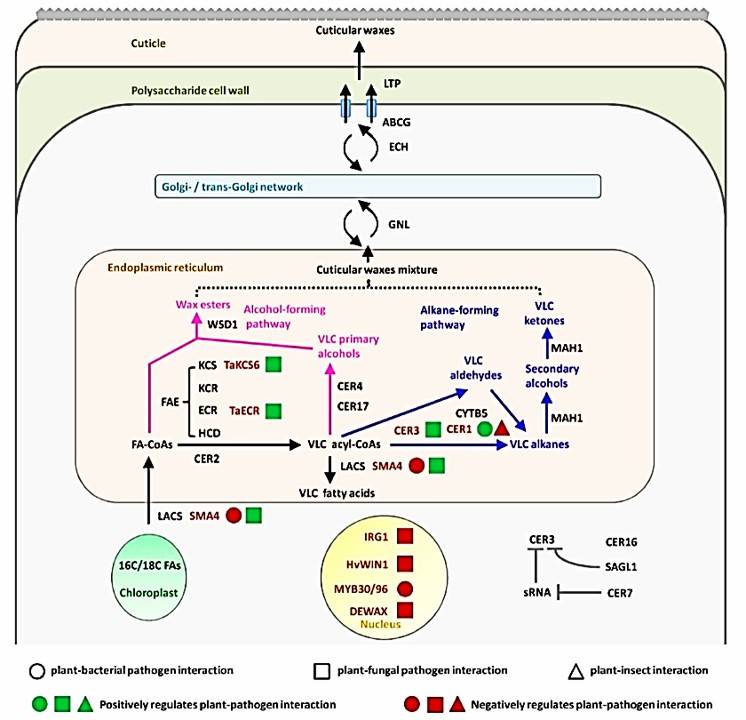Lifeasible focuses on the role of the plant cuticle in plant-pathogen interactions and offers services to help study the role of cuticular waxes in plant-pathogen interactions and related factors that affect cuticular wax composition and structure.
In land plants, the cuticle is the outermost layer that interacts with the environment and is an extremely important defense layer for plants. Cuticular waxes are one of the main components of the cuticle. They are extensively involved in many physiological resistance processes, such as resistance to adverse environments, pests, and diseases. Cuticular waxes are constitutive and inducible resistance components of plants, functioning as physical barriers and regulating plant resistance to pathogens. The structure and composition of cuticular waxes influence plant-pathogen interactions. Understanding the role of cuticular waxes in plant-pathogen interactions can contribute to the development of cuticular wax-based agrochemicals and plant resistance breeding. Lifeasible supports research on plant cuticular waxes and provides specialist research services to help explore the role of cuticular waxes in plant-pathogen interactions.
 Fig. 1 A simplified model for cuticular wax biosynthesis and its roles in regulating plant-pathogen interactions (Wang et al., 2020).
Fig. 1 A simplified model for cuticular wax biosynthesis and its roles in regulating plant-pathogen interactions (Wang et al., 2020).
We help to analyze the composition or structure differences in cuticular waxes. We help analyze the effect of different cuticular wax compositions or structures on plant resistance. We also help explore the genes involved in influencing the composition or structure of cuticular waxes.
Analysis of cuticular waxes
The composition and structure of waxes affect their physical and chemical resistance. We help to extract and analyze the cuticular waxes of plants to determine the effect of wax composition on plant resistance.
Our common extraction methods are mechanical and chemical methods. We usually use gum Arabic to peel out plant epicuticular waxes. We usually use solvents such as chloroform, acetone, and dichloromethane for chemical extraction. We adjust the solvents and extraction time according to the characteristics of the plant. We use the gas chromatography-mass spectrometry method (GC-MS) to detect waxes. This method is the best technical combination for identifying and quantifying compounds present in cuticular waxes. For the mass spectrometer, we choose time-of-flight mass spectrometry (TOF MS), which can analyze multiple molecular weight compounds and has a rapid scanning speed. For compositional analysis of waxes, we use principal component analysis (PCA) to identify the tendency of group separation and analysis of variance (ANOVA) and comparison tests to identify differentially abundant waxes among the groups.
We help to detect the ultrastructure structure of the waxes. We mainly use scanning electron microscopy (SEM) to help detect the surface structure of waxes. For wax crystal structures (such as platelets, tubules, films, and rodlets), we use X-ray diffraction to detect. And we use transmission electron microscopy (TEM) to detect wax thickness.
Testing the effect of different waxes on plant resistance
We help to analyze the defenses of different structures or compositions of cuticular waxes against pathogens. We help to infect plants with different cuticular waxes using pathogens and to detect pathogen invasion or plant resistance to pathogens.
Cloning and characterization of synthetic and regulatory genes for waxes
We help clone, knock out, or knock down plant genes and detect changes in the waxes of modified plants. We help analyze the potential functions of the gene in response to plant cuticular waxes, including the synthetic and regulatory functions of cuticular waxes.
Lifeasible offers professional cuticular wax analysis services to help study the role of cuticular waxes in plant-pathogen interactions. Please contact us to serve you.
References
Lifeasible has established a one-stop service platform for plants. In addition to obtaining customized solutions for plant genetic engineering, customers can also conduct follow-up analysis and research on plants through our analysis platform. The analytical services we provide include but are not limited to the following:
Get Latest Lifeasible News and Updates Directly to Your Inbox
Mechanisms Regulating Plant Chloroplast Biogenesis
April 15, 2025